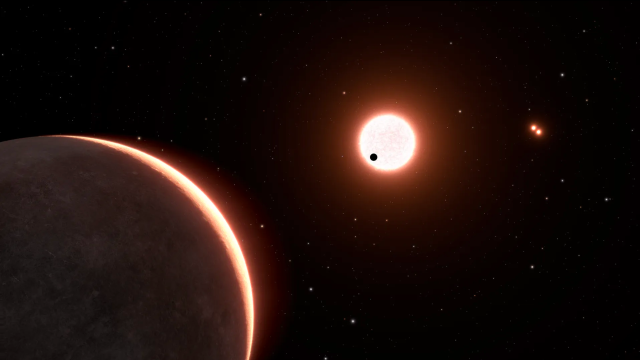The Hubble Space Telescope last week ogled an exoplanet passing in front of a star in a triple system, revealing the nearby world’s mass.
The world is named LTT 1445Ac, and it was discovered in 2022 by NASA’s Transiting Exoplanet Survey Satellite (TESS). The world orbits a red dwarf star (one in a set of three) that is 22 light-years from Earth, in the constellation Eridanus. LTT 1445Ac shares its host star with two larger planets.
TESS doesn’t have the optical resolution necessary to determine the planet’s diameter accurately. Now, a team of researchers used the veteran Hubble telescope to certify the world’s size; their results are accepted for publication in The Astronomical Journal and are currently hosted on the preprint server arXiv.
“There was a chance that this system has an unlucky geometry and if that’s the case, we wouldn’t measure the right size,” said Emily Pass, an astronomer at the Center for Astrophysics | Harvard & Smithsonian, and the study’s lead author, in a NASA release. “But with Hubble’s capabilities, we nailed its diameter.”
Though the Webb Space Telescope—Hubble’s nominal successor as NASA’s marquee space observatory—has been operational for over a year, work for the older telescope hasn’t slowed. Webb takes in light at infrared and near-infrared wavelengths, meaning some observations (namely those at visible and ultraviolet wavelengths) are still the domain of Hubble.
The Hubble observations revealed that LTT 1445Ac has a diameter 1.07 times that of Earth, meaning it’s a rocky world with roughly the same gravity as our own. The similarities stop there, though: LTT 1445Ac has a surface temperature of 500° Fahrenheit (260° Celsius), piping hot—and unsuitable for life—compared to our relatively balmy planet.
“Transiting planets are exciting since we can characterize their atmospheres with spectroscopy, not only with Hubble but also with the James Webb Space Telescope,” Pass said. “Our measurement is important because it tells us that this is likely a very nearby terrestrial planet. We are looking forward to follow-on observations that will allow us to better understand the diversity of planets around other stars.”
Indeed, just this week, Webb revealed the sulfuric, sandy atmosphere of a Neptune-like gas giant about 211 light-years from Earth. Finding habitable worlds beyond our solar system is a priority for American astronomy in the next decade. Space telescopes like Webb and Hubble—and eventually the Habitable Worlds Observatory—will be key to finding them.
